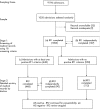Extent, nature and consequences of adverse events: results of a retrospective casenote review in a large NHS hospital
- PMID: 18055887
- PMCID: PMC2653177
- DOI: 10.1136/qshc.2006.021154
Extent, nature and consequences of adverse events: results of a retrospective casenote review in a large NHS hospital
Abstract
Objectives: To estimate the extent, nature and consequences of adverse events in a large National Health Service (NHS) hospital, and to evaluate the reliability of a two-stage casenote review method in identifying adverse events.
Design: A two-stage structured retrospective patient casenote review.
Setting: A large NHS hospital in England.
Population: A random sample of 1006 hospital admissions between January and May 2004: surgery (n = 311), general medicine (n = 251), elderly (n = 184), orthopaedics (n = 131), urology (n = 61) and three other specialties (n = 68).
Main outcome measures: Proportion of admissions with adverse events, the proportion of preventable adverse events, and the types and consequences of adverse events.
Results: 8.7% (n = 87) of the 1006 admissions had at least one adverse event (95% CI 7.0% to 10.4%), of which 31% (n = 27) were preventable. 15% of adverse events led to impairment or disability which lasted more than 6 months and another 10% contributed to patient death. Adverse events led to a mean increased length of stay of 8 days (95% CI 6.5 to 9). The sensitivity of the screening criteria in identifying adverse events was 92% (95% CI 87% to 96%) and the specificity was 62% (95% CI 53% to 71%). Inter-rater reliability for determination of adverse events was good (kappa = 0.64), but for the assessment of preventability it was only moderate (kappa = 0.44).
Conclusion: This study confirms that adverse events are common, serious and potentially preventable source of harm to patients in NHS hospitals. The accuracy and reliability of a structured two-stage casenote review in identifying adverse events in the UK was confirmed.
Similar articles
-
The incidence of adverse events in Swedish hospitals: a retrospective medical record review study.Int J Qual Health Care. 2009 Aug;21(4):285-91. doi: 10.1093/intqhc/mzp025. Epub 2009 Jun 25. Int J Qual Health Care. 2009. PMID: 19556405 Free PMC article.
-
Comparison of three methods for estimating rates of adverse events and rates of preventable adverse events in acute care hospitals.BMJ. 2004 Jan 24;328(7433):199. doi: 10.1136/bmj.328.7433.199. BMJ. 2004. PMID: 14739187 Free PMC article.
-
Preventable in-hospital medical injury under the "no fault" system in New Zealand.Qual Saf Health Care. 2003 Aug;12(4):251-6. doi: 10.1136/qhc.12.4.251. Qual Saf Health Care. 2003. PMID: 12897357 Free PMC article.
-
Measuring harm and informing quality improvement in the Welsh NHS: the longitudinal Welsh national adverse events study.Southampton (UK): NIHR Journals Library; 2017 Feb. Southampton (UK): NIHR Journals Library; 2017 Feb. PMID: 28252896 Free Books & Documents. Review.
-
Incidence of adverse events, preventability and mortality in gynaecological hospital admissions: A systematic review and meta-analysis.Aust N Z J Obstet Gynaecol. 2019 Apr;59(2):195-200. doi: 10.1111/ajo.12937. Epub 2019 Jan 20. Aust N Z J Obstet Gynaecol. 2019. PMID: 30663036
Cited by
-
How effective are patient safety initiatives? A retrospective patient record review study of changes to patient safety over time.BMJ Qual Saf. 2015 Sep;24(9):561-71. doi: 10.1136/bmjqs-2014-003702. Epub 2015 Jul 6. BMJ Qual Saf. 2015. PMID: 26150548 Free PMC article.
-
Learning from preventable deaths: exploring case record reviewers' narratives using change analysis.J R Soc Med. 2014 Sep;107(9):365-75. doi: 10.1177/0141076814532394. Epub 2014 Apr 29. J R Soc Med. 2014. PMID: 24781159 Free PMC article.
-
[Risk management in anesthesia and critical care medicine].Anaesthesist. 2016 Jun;65(6):473-88. doi: 10.1007/s00101-016-0189-9. Anaesthesist. 2016. PMID: 27273109 Review. German.
-
Nurses' Perception of Patient Safety Culture in a Referral Hospital: A Cross-Sectional Study.Int J Environ Res Public Health. 2022 Aug 16;19(16):10131. doi: 10.3390/ijerph191610131. Int J Environ Res Public Health. 2022. PMID: 36011763 Free PMC article.
-
Preventable hospital mortality: learning from retrospective case record review.JRSM Short Rep. 2012 Nov;3(11):77. doi: 10.1258/shorts.2012.012077. Epub 2012 Nov 30. JRSM Short Rep. 2012. PMID: 23323195 Free PMC article.
References
Publication types
MeSH terms
LinkOut - more resources
Full Text Sources

